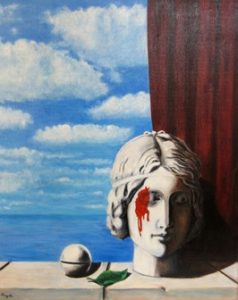I first saw Magritte’s “La Memoir” or “Mnemosyne” on a book jacket 20 or more years ago. She is an arresting image, Memory with a wound to her head. Is it memory bleeding out? Will memory be lost if the wound is not bandaged and the blood flow stopped? Or does she show the wound to the head that any of us has from one or another childhood insult or injury? Does the effort to re-member heal the wound and thus stanch the bleeding? Save the memory? And what about the bell and the leaf — are they bits of memory? Has she forgotten? Did she ever know? Are we all surrounded by artifacts of memory that if we can only see them will allow memory to heal?


With Magritte’s Mnemosyne, we can consider the possibility that the blood is an image, a memory, memory sticking the colorless face of the woman, the only sign of life we see of her. As mother of the Muses, Mnemosyne would give birth to spontaneous impulses toward speech, song, art, dance, poetry, and other manifestations rendering the numinous visible and experiential — not just spoken of but enacted, enacted here in the splash of red on her head.
Think about a vivid dream you have had. When you write, it becomes something other than the dream. It becomes a text, an adaptation of the dream, but the dream, consisting of images, cannot be fully and accurately captured in words. The same with memory. The experience remembered is not a record, faithful in every detail. The memory is particular to the rememberer. Even in a family, the same event can and often is recalled differently by parents and children, even by siblings.

